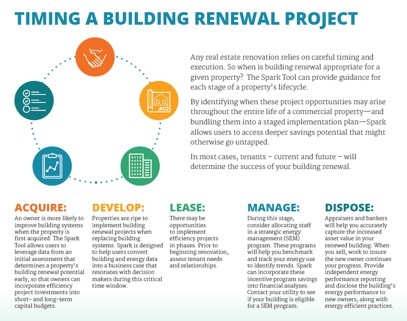What if you could quickly and easily estimate the costs and savings for a large, complex energy retrofit project at your building? What if you could also assess the value creation opportunity based on that project and easily communicate it to building owners to get their buy-in? Spark, a free, online tool brought to you by BetterBricks lets you do just that. The steps described below in this toolkit will help you to identify whether your building is a good fit for a Spark analysis and give you the tools to leverage your Spark report to obtain buy-in from building ownership for an energy retrofit project.
Spark is an early assessment tool that complements a broader building renewal strategy, a commercial real estate approach to modernize and improve a building’s competitive position. By looking at building systems holistically and identifying opportunities for deep energy retrofits, building renewal projects can deliver energy savings of 35 percent or greater. Spark enables you to assess and pursue a building renewal strategy across your portfolio. You can explore potential packages of whole-building efficiency measures and creates an integrated financial and technical report to present to ownership.
Start by entering information about the building’s systems, including a full year of utility data, and factors that determine the building’s financial valuation, such as occupancy and rental rates. Based on these inputs, Spark will provide a customized, preliminary analysis of an integrated measure packages that will achieve deep energy savings for the building. This analysis is driven by Spark’s rigorous energy modeling capabilities, which leverages EnergyPlus and Open Studio, and adds project cost analysis, expense planning, and market benefits for deep energy retrofits. The tool allows you to build a building renewal business case that resonates with building owners and works within their investment priorities.
Use the step-by-step guide below to identify which of your buildings are a good fit for a Spark Tool analysis and get started customizing your own building report. Remember, Spark has been designed more to highlight what can be done to upgrade your building tomorrow and less about what type of systems you currently have in your building today! We encourage you to see for yourself how Spark can apply to your building by using the free online tool today.
1. Identify which of your buildings could benefit from a Spark assessment.
- Buildings with the following characteristics are the best fit for the Spark Tool
- Commercial offices greater than 20,000 square feet
- Built prior to 1997
- Use the Spark Quickscreen to see if your building is a good candidate in just a few minutes.
- Discover what opportunities exist for your building at this stage of its lifecycle.

2. Generate a building-specific Spark report to assess an integrated package of energy efficiency measures.
- The tool estimates project cost and energy savings and presents the findings in a user-friendly report with three primary components: business case analysis, energy performance analysis, and detailed project scope.
- The business case analysis calculates the internal rate of return (IRR) Net Present Value (NPV) for the overall building renewal project, as well as the individual cash flow streams created by the project.
- The value creation opportunity is broken out into the present values of long-term asset appreciation, rent differential, energy savings, and reduced O&M expense
- Estimated project costs includes applicable incentives from your local utility
- Key assumptions reflect user inputs to the “sensitivity analysis” for business considerations such as the discount rate, capitalization rate, and expected inflation for a given user’s organization
- The energy performance analysis calculates reductions in energy use, energy cost, as well as annual cost savings for the entire package of measures.
- The project scope section provides descriptions of each of the recommended measures.
3. Work with ownership to incorporate a building renewal project proposal into an existing capital budget.
- Review the basics of how improved energy performance can boost your net operating income (NOI) and increase your property’s asset value.
- Spark allows users to conduct sensitivity analysis of project financial returns and modify scenarios to explore the combination of cost or savings assumptions that influence project returns.
- Spark bundles efficiency measures to justify deep energy retrofit investments when certain measures, on a standalone basis, may not meet an owner’s cost benefit thresholds.
4. Present to the right decision makers at the right time to obtain project buy-in.
- Approach ownership in the first half of the fiscal year, or earlier, when management is building and finalizing the capital budget.
- In this window, decision makers will be more receptive to exploring opportunities to increase their asset value through large capital improvement projects.
- Every decision maker has their own list of priorities so it’s always best to approach them with a wide variety of financial, energy, and non-energy benefits. Occupant comfort and wellness can be just as valuable as reduction in energy and operations and maintenance costs.
5. Communicate the non-financial benefits and opportunity to gain competitive advantage in real estate markets.
- Buildings with higher energy performance provide a host of benefits for building owners and managers, including improved tenant comfort, higher rental rates, ability to attract higher quality tenants, and increase occupancy.
